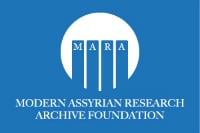By: Hanna Hajjar
Part: III
RECOMMENDATIONS
Where does the church leadership stand on all this Seyfo booklet?
Having completed the commentary, we arrive at the question of where does the new Patriarch Mor Afram II stand concerning this issue? With his seal at the opening of the Seyfo booklet, the questions that arise are:
• Did he read and endorse what was written? Or
• Did he just stamp his approval without reading the material?
If the Patriarch approved what was written after reading it, then he had knowingly automatically excluded the Assyrian members of his own church, let alone endorsed shady historical facts.
If the Patriarch didn’t read what was written, (maybe he was busy traveling and tending to other emergencies), then the blame falls completely on the authors /writers.
But now that the Patriarch is alerted to the mess that the authors/writers got the Syriac church in, it is his responsibility to fix this problem! Now he has the chance to hear the other side, and order amendments and the fixing of the writers’/authors’ mistakes. The ball is in his court!
Since Bishop Afram Karim became the new Patriarch of the Syriac Orthodox Church, almost a year ago, we have seen him traveling all around the world, many of which were humanitarian and dealing with the sufferings of his congregation in north Iraq and Syria, and that is greatly appreciated. But the problem that we have with the booklet is very important too, especially that it deals with our history, and what is causing this, is in the interpretations of certain terminologies! And that can be easily fixed if the patriarch wants too, and it will keep us in limbo if the patriarch doesn’t want to, or doesn’t care!
The Patriarch in making speeches, where he uses slogans such as “Syriacs, Assyrians, and Chaldeans, are one people”, and calling for the “Unity”, and that “He is Everyone’s Patriarch”, (i.e. within his Syriac Orthodox Church). Well the question here is: With all due respect to the Patriarch, what exactly does he mean with those terms? We ask this question because this is the essence of our problem, and it always has been shoved under the rug, and not addressed, and now it had blown up in our faced right at the commemoration of the 100 anniversary of Seyfo! So it would be very wise to address, and tackle it, once and for all.
On one hand, the patriarch had officially claimed that he is Aramean, and I respect his views of what he believes himself to be. But with the same token there are many members within his own church who do not share his ethnic identity, after all the Syriac Church evangelized many nations, and that is why it has Indians, Assyrians, and Arabs, who are not only Arameans members. Now this issue would not be a problem if there is tolerance within the Syriac Church, but when church leaders allow the secular Arameans to spread their propaganda, and ideology of the hate of others within the church and launch anti-Assyrian campaign, then we are faced with an issue of oppression, discrimination, and exclusion of other members, allowing the Arameans group to highjack the church, consequently that leads the Assyrians within the Syriac Orthodox Church to believe that they are excluded and not welcome by the Patriarch, and hence implying that the Patriarch does not represent them! A simple proof is the Church booklet about Seyfo, where theauthors/writers completely excluded the Assyrian-Syriac Orthodox victims, as if they didn’t exist at all, and they catered only to Arameans of the Levant who were not even subjected to any Seyfo genocide.
I am not going to dwell on this; Instead, I will list a simple solution below and a recommend that the Patriarch takes it into consideration, and addresses the issue very soon, because the 100th anniversary is coming in almost one moth from now. The Patriarch needs to take action if he is seriously interested in unifying his own church, and if he really want to be the Patriarch of everyone within his church! The decision is all his!
When the patriarch says “Syriacs, Assyrians and Chaldeans, are One People”;
* Is he excluding the “Arameans”? Or is he implying that the “Syriacs” are the “Arameans”?
* And if he thinks that "Syriacs" means "Arameans" only, then there are many others (including previous Patriarchs of the Syriac church), who don’t share that definition based on historical facts, because obviously the Syriac Church evangelized many nations!
* Furthermore, when the patriarch says “Assyrians”, is he talking about the Assyrians within his Syriac Orthodox Church? Or is he talking about the “Assyrians” of the “Assyrian Church of the East”?
Because if it is within his own church then that contradicts Syriacs = Arameans. And if it is outsides his own church, then he is not recognizing the Assyrians within his own church!
* Additionally when he combines “Syriac, Assyrian, & Chaldeans” is he talking about three different churches (i.e. Syriac Orthodox Church, Assyrian Church of the East, and Chaldean Catholic Church), (i.e. those names to him are denominations/sects names), or is he combining three different ethnic groups, (i.e. every Syriac speaking denomination/sect is a combination of those three ethnicities or nations?
* When the patriarch talks about “Unity”, is he talking about unity among all the different Syriac-speaking churches? Unity amongst generic Christian Churches Worldwide? Or unity amongst the different ethnicities within his own Syriac Orthodox Church?
As you see those terms if not strictly explained, they are very confusing, and people are not fortune tellers to guess what the Patriarch means! Those slogans are ambiguous, and confusing, they need to be very clear and interpreted in one way only, so that we truly understand what is really meant, and not what is said! Especially that the Aramean side is promoting its ideology claiming that Assyrians are extinct, and they don’t exist and that Syriac exclusively means Aramean. Based on all this, the key point that the Patriarch needs to clarify is to specifically clear this ambiguity. Do “Assyrians” exist to him or not? Are there Assyrians within his church or not? Because according to some of his subordinate clergymen Assyrians don’t exist! Based on this, and as Assyrians within the Syriac Orthodox Church, this is what we believe that the patriarch needs to clarify ones and for all:
a- What is the status of Assyrians within the Syriac Orthodox Church? Does the Patriarch recognize them or not?
b- If the Patriarch recognizes them, then are Assyrians members equal to Arameans, Indians, and Arabs, within his church, or is there an ethnic and class discrimination practiced within the Syriac Orthodox Church?
c- What is the official Syriac Orthodox Church definition of the term “Syriac”, “Syrian”, “Assyrian”, “Aramaic”, & “Aramean”?
The Patriarch Mor Afram II needs to issue an official declaration clarifying and defining exactly the identity of the Syriac Orthodox people based on the above three questions. He should not leave it to the interpretation of his slogans, nor to the definitions spread by non-Syriac Orthodox people who are trying to inject their own interpretations to create a split within the Syriac church, nor leave it to the illiterate ignorant people!
Years ago in Sweden when the situation flared up between the Assyrian and Aramean groups there, Patriarch Mor Zakka issued a declaration that we are all Syriacs and banned the use of both Assyrian and Aramean names, as it turned out this didn’t work, because the church clergymen took the side of the Arameans and allowed them to promote their name in church while they banned the Assyrians from doing the same. The following is a guideline of what is expected to fix this problem:
• The foundation to build this declaration on is to be based on the historical writings of the historian Mor Mikhael Rabo one of the Patriarchs of the Syriac Orthodox Church, where he mentions both Assyrians and Arameans as parts of the Syrian church, (noting that at that time he was talking about the both the Jacobite and Melkite branches), and years later Patriarch Mor Yacoub III, wrote a similar definition.
• Based on that Assyrians would like to see the Patriarch issuing a declaration stating that:
The Syriac Church in the Middle East, is made of “Assyrians”, and “Arameans”, and any statements issued by Arameans do not reflect the views of the Syriac Orthodox Church, since the Syriac Orthodox Church is not made of Arameans only.
• Anything less than that would imply that “Assyrians” within the Syriac Orthodox Church are not recognized, and hence they are not welcome there! Then the Assyrians would look elsewhere for a church that welcomes them and treats them as equals, or even create their own independent church, just like the “Indian Syriac Orthodox Church” did in India. If the Indians did it, the Assyrians can do it too!
• According to the Seyfo booklet, the Syriac Orthodox Church doesn’t recognize the Assyrian Orthodox victims; so what reason do Assyrian Orthodox have to attend the Syriac Church’s Seyfo commemoration on April 24th 2015? Is it to commemorate the so called Aramean victims? As you see there is nothing to attract Assyrian Orthodox to the church then!
With all due respect to the Patriarch, now the ball is in his court, and we hope that he would make the right decision, and resolve this problem before April 24th 2015, because if this is not resolved by then, he would be the Patriarch of the Arameans only, and not the Patriarch of all Suryoye!
Add to that, the fact that if Assyrians are excluded, then the burden of proof is on the shoulders of the current Patriarch to prove that his predecessor Patriarchs Mar Mikhael Rabo, Mor Afram Barsom, and Mor Yacoub III, were all wrong when they mentioned Assyrians as part of the Syriac Orthodox Church.
Continued in Parts: IV, & V.






